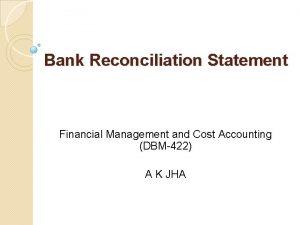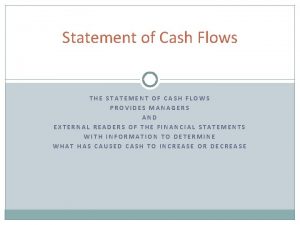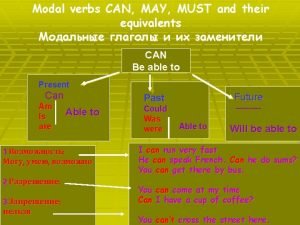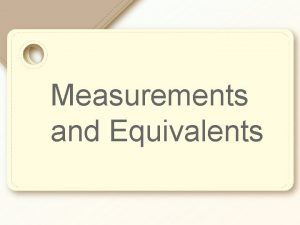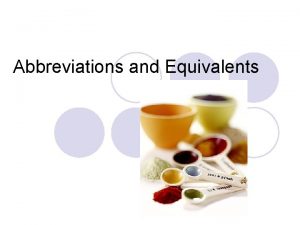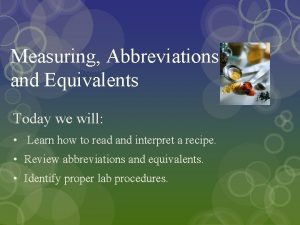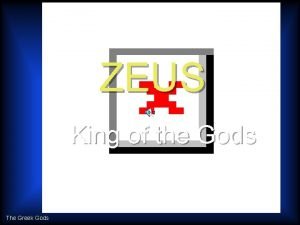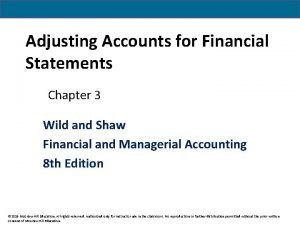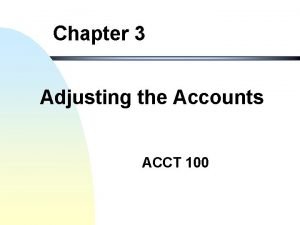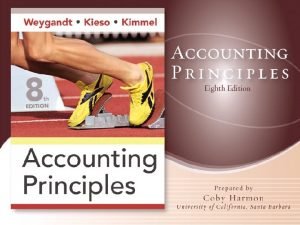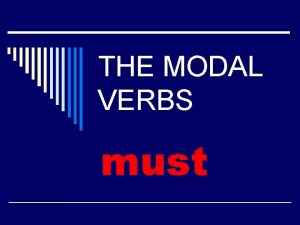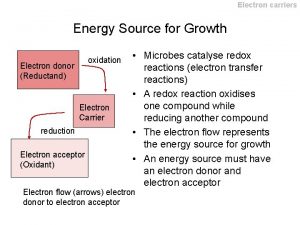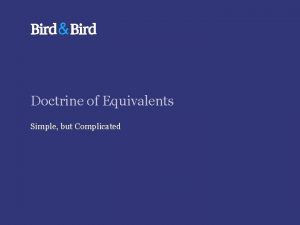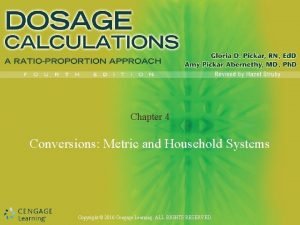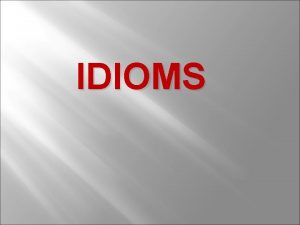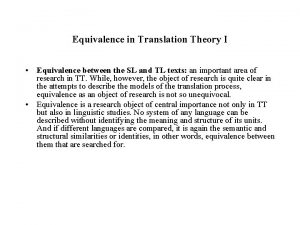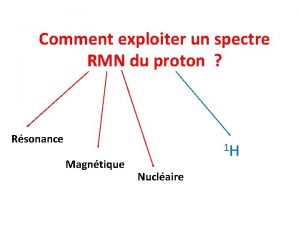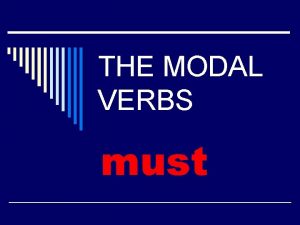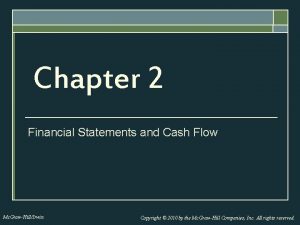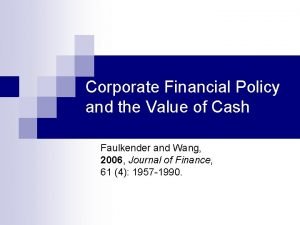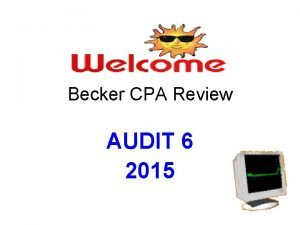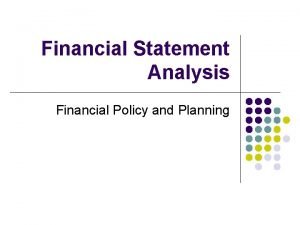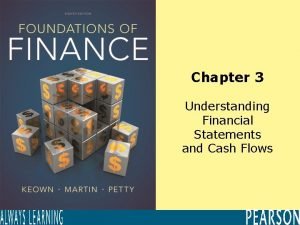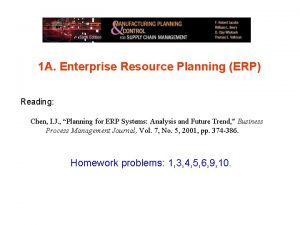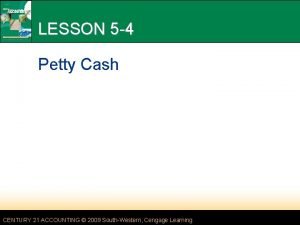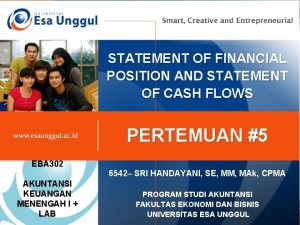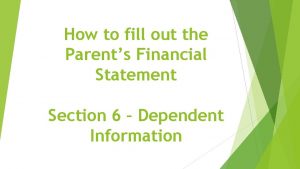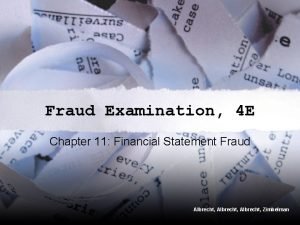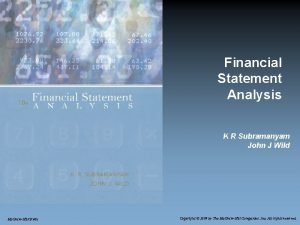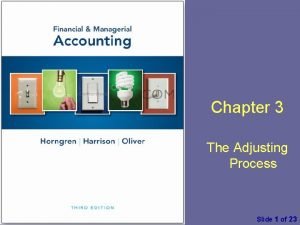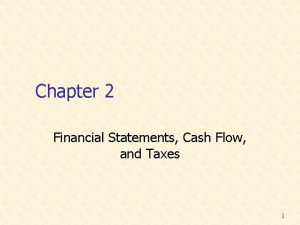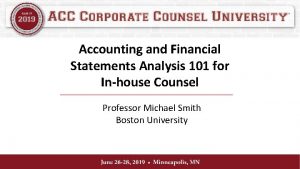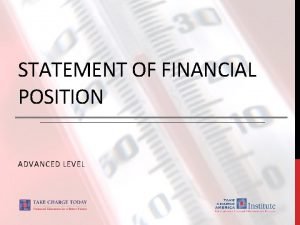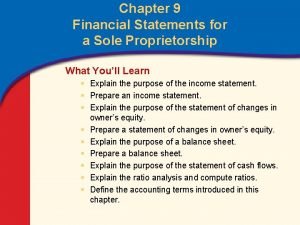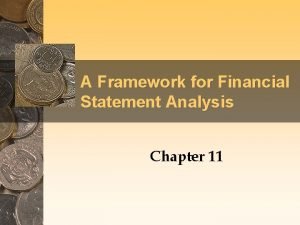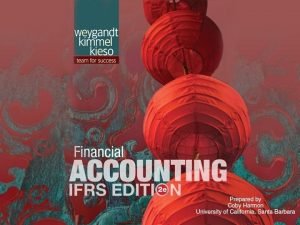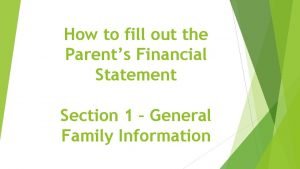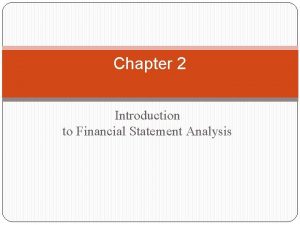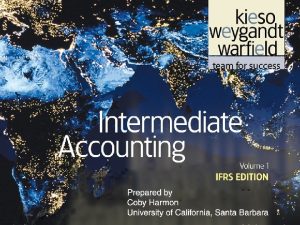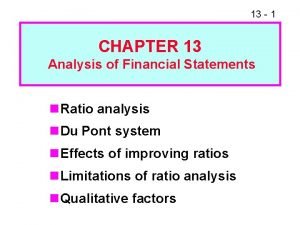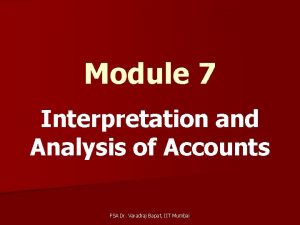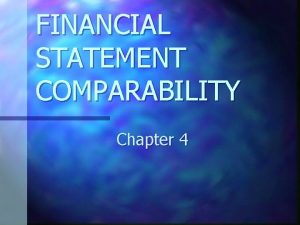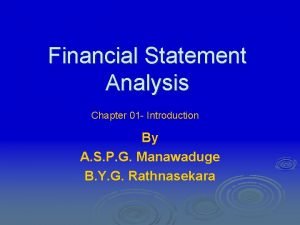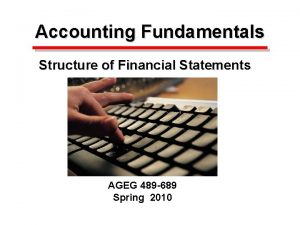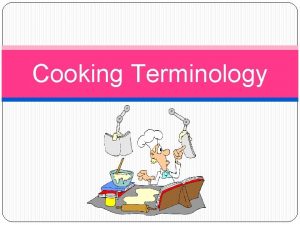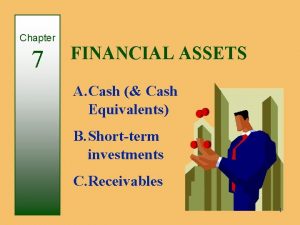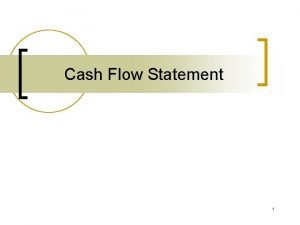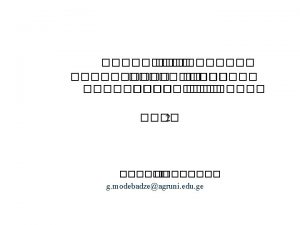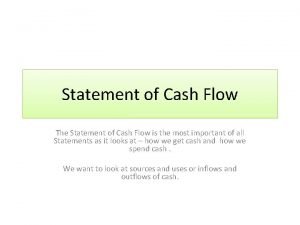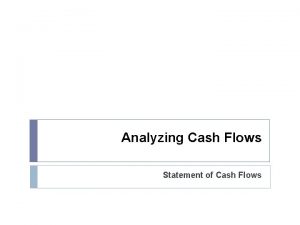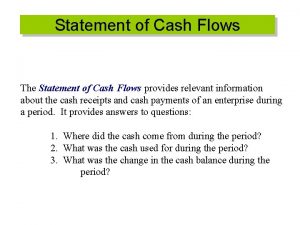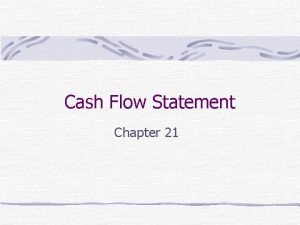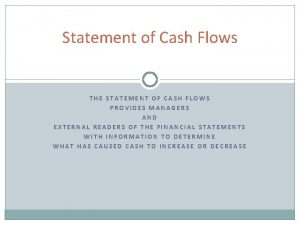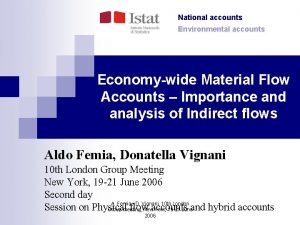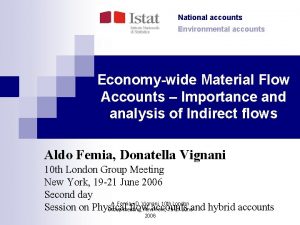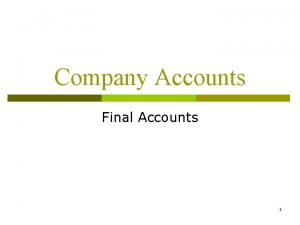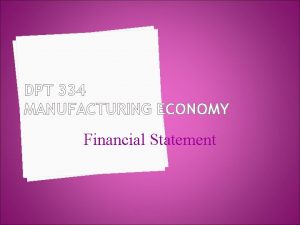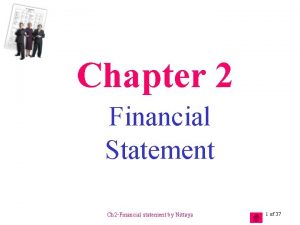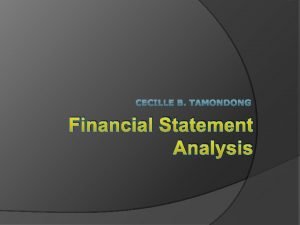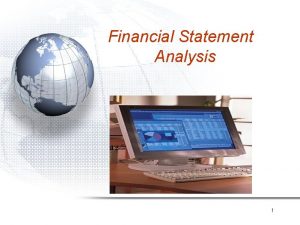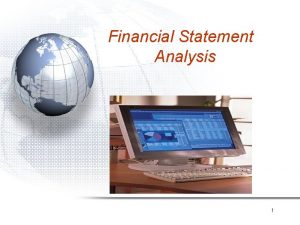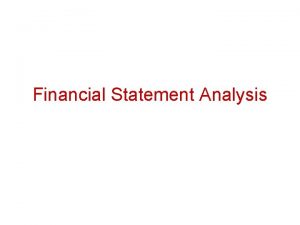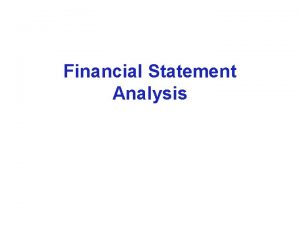Financial Statement Accounts Cash and Cash Equivalents Cash








































































- Slides: 72

Financial Statement Accounts

Cash and Cash Equivalents • Cash is considered the most liquid of assets. It is usually anonymous and highly portable. It is also a component when determining if a company has liquidity. Liquidity is the ability of a company to pay its current liabilities. Cash and cash equivalents are readily available to settle current liabilities. They are reported first as assets on the balance sheet, followed by less liquid assets. • Cash includes 1. Currency, coins, and deposits in bank accounts 2. Checks from customers and others, cashier’s checks, certified checks, and money orders • Cash equivalents include 1. Short-term and highly liquid investment instruments that are a. Readily convertible to cash b. Close enough to their due date (three months) so that market fluctuations cannot affect their value c. An instrument such as US Treasury Bills would normally qualify

Bank Reconciliation The balance of a checking account reported on the bank statement rarely equals the general ledger cash balance in the accounting records. There are timing differences between the bank and the general ledger because the bank is not up to date with amounts in the general ledger. There amounts on the books of the company that will not be recorded until the bank statement arrives.

Bank Reconciliation

Bank Reconciliation Bank Side In preparing a bank reconciliation, always reconcile the bank side (left side below) first because there are generally only two reconciling items – deposits in transits (deposits not yet recorded by the bank but recorded in the general ledger) – outstanding checks (checks written and recorded by the company but not yet received by the bank) The ending Adjusted Bank Balance will help you determine if you have properly recognized all reconciling items from the book or right-hand side. NOTE: Deposits in Transit, Outstanding Checks and Bank Errors do not require a journal entry. The ending Adjusted Bank Balance must agree to the ending Adjusted Book Balance.

Bank Reconciliation Bank Side In preparing a bank reconciliation, always reconcile the bank side (left side below) first because there are generally only two reconciling items – deposits in transits (deposits not yet recorded by the bank but recorded in the general ledger) – outstanding checks (checks written and recorded by the company but not yet received by the bank) The ending Adjusted Bank Balance will help you determine if you have properly recognized all reconciling items from the book or right-hand side. NOTE: Deposits in Transit, Outstanding Checks and Bank Errors do not require a journal entry. The ending Adjusted Bank Balance must agree to the ending Adjusted Book Balance.

Bank Reconciliation Book or General Ledger Side Reconciling items on the book side. These will come from the bank statement. Each will require a journal entry. Add: Any interest received, any collections from your customers which the bank has performed on behalf of the company, and any previously unrecorded deposits. Subtract: Any bank service charges, EFT payments, insufficient funds (NSF) checks you deposited, any fees for NSF checks, and any loan payments to the bank. (This is not an exhaustive list but a review of the bank statement will show what has been deducted from the bank account). Journal Entry Errors: 1) Reverse the original entry as though it did not happen (easier to explain and also to remember) and 2) Record the proper amount.

Bank Reconciliation • Organic Food Co. 's cash account shows a $7, 000 debit balance and its bank statement shows $6, 210 on deposit at the close of business on August 31. a. August 31 cash receipts of $2, 740 were placed in the bank’s night depository after banking hours and were not recorded on the August 31 bank statement. b. The bank statement shows a $270 NSF check from a customer; the company has not yet recorded this NSF check. c. Outstanding checks as of August 31 total $2, 620. d. In reviewing the bank statement, an $230 check written by Organic Fruits was mistakenly drawn against Organic Food’s account. e. The August 31 bank statement lists $170 in bank service charges; the company has not yet recorded the cost of these services. • Prepare a bank reconciliation using the above information.

Accounts Receivable – In general • When a company makes a sale, they are paid in one of two ways—either in cash or with a promise to pay at a later date, i. e. an Accounts Receivable (AR) • AR accounts are maintained by customer for purposes of sending out statements as well as to analyze individual receivables • The individual AR accounts are maintained in the AR subsidiary ledger and sales in the subsidiary sales journal. The general ledger will have one total for AR and Sales

Visa, Master. Card, etc. Sales • Companies can extend credit to customers (such as Lowes, Apple, JC Penney, etc. ) but most will accept third-party credit or debit cards –Visa, Master. Card, Amex, Discover • Why don’t most companies offer their own credit cards to customers? It is expensive to do so. They will earn interest on the accounts receivable, but they also pay for credit reports and staff to determine creditworthiness, record sales and payments, calculate interest, send out statements, and collect on the receivable as well as deal with customers who pay slowly or not at all. All of these activities are very expensive, and the interest earned on the AR must absorb these costs and also create a profit. However, extending credit to customers opens up the avenues to new customers more than if the company were to accept cash only. • Therefore, many companies chose to accept third-party credit cards (We will use Visa as an example)instead of extending credit themselves because Visa determines creditworthiness, sends out statements and collects from customers. The company can collect cash quicker and does not have the expense of additional staff nor worry about collections.

Visa, Master. Card, etc. Sales • Visa, etc. work out an interface between themselves and the merchants to provide proof of the transaction. There are different interfaces depending upon the merchant. • The cost of using the third-party credit card providers is a negotiated percentage that varies from third-party provider to third-party provider as well as merchant to merchant. Usually, the transaction fee is between 1 to 5% on the transaction. The third-party provider takes this fee and remits the remainder to the merchant company. • Depending upon the relationship and the attractiveness of the merchant to Visa, etc. the merchant can receive cash immediately or at a later, agreed-upon date.

Merchant Offers In-House Credit Card • When merchants extend credit to customers, it must record any bad debts as an expense of doing business. • No company expects to collect all amounts due • One side of the write-off affects the amount expected to be collected—the net realizable value (NRV) and the other side of the write off is an expense that affects net income and subsequently retained earnings. • There are two methods • The Direct Write Off Method • The Allowance Method • Calculated three ways • Percentage of Sales • Percentage of Receivables • Aging of Receivables

The Direct Write Off Method • The merchant does not predict bad debts but writes off each customer if it cannot collect on the AR • This write off is an expense of doing business • If the customer subsequently pays the amount due, the merchant reverses the prior transaction and re-establishes the customer’s accounts receivable in order to track the customer’s credit history • Then the cash payment is recorded

The Direct Write Off Method • The Direct Write Off method is not GAAP although it is used by some companies if AR is minimal • There are two major concerns • Violations of the matching principles • Since it normally takes a while before a customer’s account is deemed uncollectible, the sales associated with the AR may be in a different financial statement period than the expense recorded when the account is written off. The sales and expense should be matched. • Materiality • If the AR balances are significant, then the materiality constraint is violated and would require the merchant to estimate bad debts. Companies using the direct write off method are expected to monitor materiality.

Allowance Method Allowance for Doubtful Accounts or Allowance for Bad Debts • The company makes an estimate of bad debts to match the expense to sales in the current month. AR will be reported at is net realizable value—the expected cash collection. • Shown on the Balance Sheet as

Allowance Method • The original AJE establishes an estimate based on experience but is not related to a specific customer’s account but rather accounts receivable in its totality. • Account receivable for the specific customer is written off. • The allowance is reduced because a portion of the estimate has been realized as a bad debt. • Since both the allowance and the total amount in AR are reduced by an equal amount, this transaction has no effect on net realizable value

Allowance Method Percentage of Sales Calculation • Often referred to as the income statement approach, it focuses on sales. Assumes a percentage of sales will be uncollectible based upon merchant’s credit policy and current economic environment • • • Current month sales are $90, 000 Experience has shown 2% of sales are uncollectible Calculation - $90, 000 x 2% = $1, 800 The calculation is repeated each accounting period based on the current period’s sales. The balance in the account Allowance for Bad Debt is not considered when using this method.

Allowance Method Percentage of Receivables Calculation • Often referred to as the balance sheet approach, the balance in accounts receivable is considered and the adjustment calibrated to achieve the desired effect on the Allowance for Bad Debts resulting in the estimated ending balance. • Assumes a portion of AR will be uncollectible based on company experience and current business environment.

Allowance Method – Aging of Receivables • The journal entries are not different from the Percentage of Receivables calculation but is more complex. • The focus is on layers of accounts receivable based upon how long the accounts receivable has been due. Various percentages are applied with the larger percentages applied to those balances that have been outstanding longer. • Percentages are based upon the company’s experience and current economic climate. • The percentages are applied against each layer, added together and become the basis for the adjustment.

Aging Method Calculation

Selling Receivables • Sometimes companies will sell their receivables to a bank or a factor in order to realize collections earlier. • The bank or factor takes a percentage of the AR as their fee and may or may not assume the risk of collection. • Selling to a factor with recourse = Company still at risk for collection • Selling to a factor without recourse = Company is no longer at risk

Pledging Receivables • Companies can also pledge their receivables as security for a loan. • Company still has collection responsibilities • Nothing is recorded by the company since ownership does not pass to the bank. However, these facts must be disclosed in the notes to the financial statements.

Exercise 5 -6 A • December 31, Year 1 • The accounts receivable balance for Renue Spa was $61, 000. • Also on that date, the balance in the Allowance for Doubtful Accounts was $3, 750. • Total retained earnings at the end of Year 1 was $57, 250. • During Year 2, • $2, 100 of accounts receivable were written off as uncollectible. • In addition, Renue unexpectedly collected $500 of receivables that had been written off in a previous accounting period. • Services provided on account during Year 2 were $215, 000, and cash collections from receivables were $218, 000. • Uncollectible accounts expense was estimated to be 2 percent of the sales on account for the period.

Exercise 5 -7 A Joey’s Bike Shop sells new and used bicycle parts. Although a majority of its sales are cash sales, it makes a significant amount of credit sales. During Year 1, its first year of operations, Joey’s Bike Shop experienced the following: Assume that Joey's Bike Shop uses the allowance method of accounting for uncollectible accounts and estimates that 1 percent of its sales on account will not be collected.

Recording external and internal transactions Many transactions are consummated with parties external to the company. However, there are internal transactions a company will record such as office supplies, prepaid items, and unearned revenue. These accounts are adjusted internally to ensure that the balance sheet and income statement are properly valued—using the time period assumption. The originally recorded amounts are used up internally and are recognized by the company for such use. Revenues are recognized when earned not when paid. Expenses are matched to revenue recognition.

Office Supplies are an asset which will be used up over time. This usage creates an expense to be matched against the revenues they helped to generate. If a company purchases $9, 720 of supplies during the month of December and some of the supplies were used during the month. When financial statements are prepared as of December 31, the cost of supplies used during December must be recognized as an expense because the supplies were used to generate income. (Matching principle and Time Period Assumption) Thus, the usage of this asset becomes an expense to match against revenue. • When the company takes physical count of its remaining, unused supplies at December 31, it finds $8, 670 of supplies on hand. The supply expense would be $1, 050 as these supplies must have been used by company employees in the month of December. This is December’s supply expense and requires an adjusting journal entry to ensure the balance sheet and income statement are correct.

Prepaid Expenses and Unearned Revenue Prepaid expenses refer to cash paid in advance of receiving a product or service. • They reflect transactions for more than one period of time and are therefore not expenses. • When these assets are used, their costs become expenses. If a company prepaid insurance in the amount of $2, 400 for 12 months of insurance benefits. • With the passage of time, the benefits of the insurance gradually expire, and a portion of the Prepaid Insurance asset becomes expense. • This expense is $200 each month, which leaves $2, 300 as an asset account balance. Unearned revenues refers to cash received in advance of providing products and services. • Unearned revenues are liabilities. • When cash is accepted, an obligation to provide products or services is incurred. • As products or services are provided, the unearned revenues become earned revenues. • Adjusting entries for unearned revenues involve increasing revenues and decreasing unearned revenues. • For instance, one if a company receives $2, 400 for 12 months of insurance, as each month passes, the company will recognize $200 of revenue and an equal decrease of the liability or $2, 300

Exercise 2 -12 A On April 1, Year 2, Maine Corporation paid $18, 000 cash in advance for a one-year lease on an office building. Assume that Maine records the prepaid rent as an asset and that the books are closed on December 31. Show the payment for the one-year lease and the related adjusting entry to recognize rent expense in the accounting equation.

Exercise 2 -17 A On October 1, Year 2, Stokes Company paid Eastport Rentals $4, 800 for a 12 -month lease on warehouse space. Record the related December 31, Year 2, adjustment for Stokes Company in the accounting equation. Record the related December 31, Year 2, adjustment for Eastport Rentals in the accounting equation.

Merchandising Companies Inventory This is a new type of company which sells merchandise and not services. We will be learning the perpetual method which continuously updates the accounting records for each sale and purchase of inventory. Merchandising companies are either 1) wholesalers who buy from manufacturers and sell to retailers or 2) retailers who buy from either manufacturers or wholesalers and sell to the final customer. Supposed there is a local retail company named “Candy Mart” which purchases from the large candy manufacturers and sells to local candy stores for gift baskets.


At the end of the month: What can happen to Goods Available for Sale (GAFS) during the month? Cost of Goods Sold represents the costs of buying and preparing merchandise for sale Usually COGS is calculated as:

Typically, revenues refer to service companies; whereas sales refer to merchandising or retail companies. When a retail company sells merchandise, they record the payment for the merchandise, sales, cost of the sale (inventory), and a reduction of inventory. • • Payment for the merchandise will either be cash or accounts receivable—a balance sheet item. Sales of the merchandise will be recorded on the income statement. Cost of sales (value of inventory) will be recorded on the income statement Reduction of inventory will be recorded on the balance sheet. • The sale of inventory effectively moves inventory (as asset) from the balance sheet to the income statement in the form of cost of sales.

Purchases of Inventory When a company purchases inventory, the company records an increase in the asset inventory and the method of payment—either cash or accounts payable.

Multi-Step Income Statement Note: Gross Profit (Net sales minus COGS) Gross profit is calculated as GP/Net Sales which yields 27%. This means there is 27% of income available for other expenses after paying the costs of inventory (GOGS). Inherently, the computation is saying 73% of net sales is spent on purchasing inventory.

Classified Balance Sheet for Merchandisers • Operating cycles for companies are usually one year—the definition is a year or the company’s operating cycle which ever is longer. • The company’s operating cycle is defined as the time span from which cash is used to acquire goods/services until cash is received from the sales of goods/services. • Operating cycles determine which assets are expected to be used up in the current period and are classified as “current. ” • If an item is not deemed “current, ” it is considered to be long-term. • Operating cycles for merchandisers are usually less than a year. • Inventory is always a current asset.

Inventory Methods • When inventory is purchased at different prices, what price do we use as cost of goods sold? There are four (4) methods • The reasons for choosing one method over another revolves around profit planning, tax implications, practical considerations, etc. Companies can choose any method but must remain consistent in their use of a method. • The method chosen is not required to mimic the actual flow of goods. Ex A grocery store’s flow of merchandise is first in first out but it can cost its inventory using any one of the four methods

Inventory Records for Campus Tablets

The Four Inventory Cost Flow Methods that companies can choose • Specific identification – specifically identifies each sale. Used for real estate, Rolexes, cars—usually high dollar items/low volume sales • Weighted Average – Averages out the cost flows among the purchases at different amounts. Results in cost of goods sold (COGS) with fewer spikes • Lifo – Last items in are considered the first ones to be sold. At a time of price increases—results in high COGS (lower gross profit) and lower inventory value. At a time of price decreases, just the opposite. • Fifo – First items in are considered to the first ones to be sold. At a time of price increases—results in lower COGS (higher gross profit) and a higher inventory value. At a time of price decreases, just the opposite.

Comparison

Long Term Assets Property, Plant and Equipment 1. Types of Assets 2. Cost of Assets 3. Depreciation 4. Disposal

Characteristics Plant assets are tangible assets used in a company's operations that have a useful life of more than one accounting period. Plant assets are also called fixed assets. For many companies, plant assets make up the single largest class of assets they own. Plant assets are set apart from other assets by two important features. • First, plant assets are used in operations. • This makes them different from, for instance, inventory that is held for sale and not used in operations. The distinctive feature here is use, not type of asset. A company that purchases a computer to resell it reports it on the balance sheet as inventory. If the same company purchases this computer to use in operations; it is a plant asset. • The second important feature is that plant assets have useful lives extending over more than one accounting period. • This makes plant assets long term and not a current asset such as supplies that are normally consumed in a short time period after they are placed in use.

Characteristics Since plant assets are used in operations, companies match their costs against the revenues they generate in a systematic and rational manner over the usesful life of an asset. This process is called “depreciation. ” Depreciation is a non-cash transaction. Depreciation is an expense found on the income statement, and this transaction also affects the net book value of an asset. The portion of the transaction that affects net book value is called “accumulated depreciation. ” Accumulated depreciation is shown on the balance sheet: Land An important exception is land; land cost is not allocated to expense. Land is expected to have an indefinite life.

Reporting Accumulated Depreciation • Both the cost and accumulated depreciation of plant assets are reported on the balance sheet or in its notes. Reporting both the cost and accumulated depreciation of plant assets helps users compare the assets of different companies. • For example, a company holding assets costing $50, 000 and accumulated depreciation of $40, 000 is likely in a situation different from a company with new assets costing $10, 000. While the book value of $10, 000 is the same in both cases, the first company is likely facing the need to replace older assets. These insights are not provided if the two balance sheets report only the $10, 000 book values or net book values.

Asset Types • Land Improvements • Buildings • Machinery and Equipment

Computing Costs Plant assets are recorded at cost when acquired in accordance with the historical cost principle. Cost includes all normal and reasonable expenditures necessary to get the asset in place and ready for its intended use. • The cost of a machine, for instance, includes its invoice cost plus any required freight, unpacking, assembling, installing, and testing costs. • If an asset is damaged during installation, the repairs are not added to its cost. The repairs are charged to expense. • Paying a fine for moving heavy machinery without a proper permit is not part of the machinery's cost, but payment for a proper permit is included in the cost of machinery. • Charges are sometimes incurred to modify or customize a new plant asset. These charges are added to the asset's cost.

Land When land is purchased for a building site, its cost includes the • total amount paid for the land, including any real estate commissions, title insurance fees, legal fees • any accrued property taxes paid by the purchaser • payments for surveying, clearing, grading, and draining • government assessments, whether incurred at the time of purchase or later, for items such as public roadways, sewers, and sidewalks. These assessments are included because they permanently add to the land's value. Land purchased as a building site for a future building sometimes includes structures that must be removed. Add the cost of removal and subtract any salvage proceeds. • A company pays $180, 000 cash to acquire land for a retail store. • This land had an old structure that was removed at a cost of $10, 000 • The company obtains salvage proceeds of $3, 000 from selling components of the old structure • Closing costs total $9, 800

Land Improvements Land has an indefinite life and is not used up over time. However, Land improvements have a limited life. Land improvements include such items as • • • parking lot surfaces, driveways, fences, shrubs, lighting systems The costs of these improvements increase the usefulness of the land, but they are recorded in the general ledger in a separate Land Improvement account so that their costs can be depreciated in accordance with the future periods they benefit. This expense is “matched” to the revenues earned during these periods as the assets were put in place to help the company earn revenue.

Buildings A Building account is charged for the costs of purchasing or constructing a building that is used in operations. When purchased, a building's costs usually include all the necessary and reasonable costs to procure the building. • purchase price, • brokerage fees, • title fees • attorney fees • all expenditures to ready it for its intended use, including any necessary repairs or renovations such as • wiring, • lighting, • flooring

Machinery and Equipment The costs of machinery and equipment consist of all costs normal and necessary to purchase them and prepare them for their intended use. These include the • purchase price, • tariffs • transportation charges, • insurance while in transit • installing, assembling, and testing of the machinery and equipment.

Lump Sum Purchase Plant assets sometimes are purchased as a group in a single transaction for a lump-sum price. The land, structure and land improvements already exist and are purchased together but need to be separately recorded for purposes of depreciation and to provide useful information on the financial statements. In order to allocate the asset values in the general ledger when there is a single price, we follow these steps • • • Obtain the appraised tax value or market value of each type of asset Add these values together Calculate the percent of each asset class as portion of the total from Step 2 Multiple the single price by these percentages Determine the apportioned cost to be recorded in the general ledger.

DEPRECIATION Depreciation is the process of systematically and rationally allocating the cost of a plant asset to expense in the accounting periods benefiting from its use. The assets were placed into service in order to help the company generate revenue and their costs must be matched to the revenue they helped to generate. Its purpose is to adhere to the matching principle of matching expenses to revenue over time. It is a non-cash transaction since it does not represent money spent when recorded—the money spent for the asset happened in the past. Depreciation does not measure the decline in the asset's market value each period, nor does it measure the asset's physical deterioration. Factors in Computing Depreciation Factors that determine depreciation are (1) cost, (2) salvage value, and (3) useful life. NOTE: Salvage value and useful life are estimates. Salvage value is an estimate of the asset's value at the end of its benefit period. Useful Life is the length of time it is productively used in a company's operations. For example, the productive life of a computer can be eight years or more. Some companies, however, trade in old computers for new ones every two years. In this case, these computers have a two-year useful life.

Depreciation Methods Depreciation methods are used to allocate a plant asset's cost over the accounting periods in its useful life. • Straight Line Method The most frequently used method. Same amount each month. • Units of Production Method – Method when assets are infrequently in use. Amount will vary from month to month. • Double Declining Balance – Method often used for tax purposes. Larger amounts at the beginning of useful life. (Companies maintain records for tax purposes in addition to financial statement purposes, and we will find in the second half of our class also for managerial decision-making purposes)

Disposal of Plant Assets Disposals of plant assets occur in one of three basic ways: discarding, sale, or exchange. We will cover discarding and sales. Discarding an Asset Sales of assets Fully Depreciated Example: A machine costing $9, 000 with accumulated depreciation of $9, 000 is discarded. When accumulated depreciation equals the asset's cost, it is said to be fully depreciated (zero book value). The asset and its related accumulated deprecation are removed from the books Sold at book value Company received $2, 500 for asset—no gain/no loss Not Fully Depreciated Example: Ex: Asset has a cost of $9, 000 and accumulated depreciation of $6, 500. Therefore, its book value is: Sold above book value Company received $3, 000 for asset—gain of $500 Sold belove book value Company received $1, 500 for asset—loss of $1, 000 The asset and the related accumulated depreciation are removed from the books, and the company recognizes a loss on discarding this asset of $2, 500. There can only be a loss when an asset is discarded—never a gain. Note: The losses or gains on either a discarded asset or a sold asset is a noncash item that is reported on the income statement. Since accumulated depreciation is a non-cash item reported to match expenses to revenue in accordance with GAAP, these gains and losses are non-cash.

Long-Term Intangible Assets • Patents – Exclusive right to patent owner to manufacture and sell item for 20 years. • Copyrights – Exclusive right to publish/sell artistic work during life of creator plus 70 years. • Franchises or Licenses – Rights granted by companies to others to sell a product or service. • Trademarks – Symbols of a company registered with the patent office • Goodwill – The amount by which a company’s total purchase price exceeds the value of its individual assets and liabilities. It is calculated as the purchase price minus the market value of net assets (assets minus liabilities)

Calculation of Goodwill

Note for homework assignments • In the statement of cash flows, all long-term asset activity is considered an investing (IA) activity.

Current Liabilities – Payable within one year or less. Financial analysis of lenders is on liquidity—the company’s ability to meet short-term (current) obligations. Typically, due within one to four months. 1. Accounts Payable (Vendors, Suppliers, Utilities, Rent). 2. Salaries/Wages Payable 3. Income Tax Payable 4. Unearned Revenue Any item to be paid with current funds. Balances in these accounts are considered by those who will lend to company on a short-term basis. Notes payable are more formal agreements and are consummated with loan documents. The legal status makes them more enforceable. Typically, they are due within six months to a year. Has an interest component in addition to the liability and payment. Interest expense is recognized related to the loan.

Long-Term Liabilities Obligations outstanding longer than a year. Financial analysis of lenders is on solvency—the company’s ability to meet long-term payments and generate future revenues. Long-Term liabilities have an interest component to compensate the lender’s whose money is at risk over a long period of time. Cash, Interest expense, and loan repayment are accounts affected by these transactions. Typical long-term liabilities are loans and installment notes GAAP requires the current portion (due within a year) to be reported among the current liabilities, and the long-term portion to be reported among the long-term liabilities.

Corporation Basics

Characteristics • Considered a separate and distinct entity from the stockholders. • Legally, it is considered an entity able to borrow money, enter into contracts, hire employees, buy and sell property. • Stockholders are the owners of the corporation and have liability limited to the value of the stock they could lose if the corporation acts poorly or improperly. Creditors cannot take personal assets of stockholders. • Stockholders, even as owners, do not make decision on behalf of the corporation. Instead, they vote for a Board of Directors who in turn hire upper management who runs the company— making business decisions on products and entering into obligations or purchases of assets on behalf of the corporation. • In liquidation, creditors must be fully satisfied, and remainder goes to stockholders because they elected the Board of Directors and upper management who ran the company poorly.

Preferred Shares • Preferred shareholders • Receive the right to dividends at a fixed rate before the common shareholders • Receive the right to assets in liquidation before common shareholders but after creditors, ie creditors are paid first before any shareholders are paid. • If the preferred shares are cumulative, receive the right to all dividends in arrears (previously not paid) before the common shareholders are paid dividends. • If the preferred shares are noncumulative, then any dividend rights to prior year dividends are forfeited; each year has a stand-alone calculation for dividends • If the preferred shares are callable, then the corporation can redeem them prior to a specific date • If the preferred shares are convertible, the shareholders have a right to convert to common shares • Do not ordinarily have voting rights

• Ownership rights are easily transferred to other buyers independent of company management. • Stockholders can sell their shares at will. • When a company has only one class of stock, the stock is common stock. Common stockholders have certain rights. • Each stockholder has a right to vote annually on the board of directors. Huge blocks of ownership shares mean these stockholders control the election of the board of directors and thus the corporation. • Share proportionally in any declared dividend • Receive the right to buy the same percentage of stock when new stock issued. (Preemptive rights). Corporation cannot issue new stock to change the percentage of stock ownership by a stockholder. • Equally share in the remaining assets in liquidation once the creditors are fully satisfied. • When a company has two classes of stock—one is common and the other is preferred

Stock Issuance • When a corporation is formed, in its charter the corporation will establish a large amount of authorized shares. These are the shares the corporation is authorized to sell. (Normally, the total amount of authorized shares far exceeds the number of shares sold. The large amount of authorizes shares allows the corporation to have shares ready to be sold without the necessity and expense of amending the charter). • In its charter the company determines if the stock will have a par value, stated value or no par value. • Stock can then be issued at par or stated value or with no par value. Stocks usually are purchased at a price above their par value. • Par value limits the amount recognized in the general ledger related to the value of the common or preferred stock. Most companies use par value not stated value. • Any amount over the par value is recorded in an account called “Paid in Capital in Excess of Par (Stated) Value, Common (Preferred) Stock. • Stock can be purchased for cash or exchanged for services or property.


Other Issues Related to Stock • A corporation can repurchase its stock from its stockholders. Repurchased shares are called “Treasury Stock. ” Authorized shares represent all shares the charter authorizes the company to sell; issued shares represent all shares sold to public or issued to employees; outstanding shares are issued shares minus any treasury shares



Calculation of Outstanding Shares

Other Issues Related to Stock • A corporation can split its stock to 2 to 1 or 3 to 1 in order to reduce the par value of the stock. The ownership percentages are unchanged when stock is split. But since the par value and shares issued change, the market value of the stock decreases making it easier for owners to sell the stock. For example, stock selling on the NYSE at $100 per share maybe hard to sell, but if a stock split occurs and it now sells for $50 per share, more shares can be sold by the stockholders. • The initial stock split has no effect on the value of in the common stock or paid in capital accounts, but the description of the stock changes from $10 par value to $5 par value. There is no need to journalize a stock split, only change the descriptions on the balance sheet and statement of stockholder’s equity.

Regulation • Corporations are heavily regulated by both federal and state governments. Each corporation must be formed in a particular state and is subject to the rules of that state. • Publicly traded shares are regulated by the federal government, and the Securities and Exchange Commission. Must follow GAAP. • Privately held corporations are owned by a small number of stockholders (Tabasco), are not publicly traded and thus are subject to fewer regulations. • Not only is the corporation taxed at the federal and local level as a separate entity but also the individual shareholders are also taxed on any dividends received.

Dividends Whether the dividend is a cash dividend or stock dividend (stockholders are given additional stock instead of cash), dividends are transactions that affect retained earnings. Dividends are not guaranteed but must be declared by the board of directors. A liability is created when declared and are paid when all stockholders are identified. The date of record is the cutoff date to identify all stockholders of record who will receive the dividend. Note: Stock dividends help keep the market price of the stock affordable.
 Bank reconciliation statement
Bank reconciliation statement Cash equivalents examples
Cash equivalents examples Fill in can may or must
Fill in can may or must Measurements equivalents and adjustments
Measurements equivalents and adjustments Teaspoon abbrevation
Teaspoon abbrevation Measuring abbreviations and equivalents
Measuring abbreviations and equivalents Eros symbols and meanings
Eros symbols and meanings The king of the greek gods
The king of the greek gods Fees earned debit or credit
Fees earned debit or credit Chapter 3 adjusting accounts for financial statements
Chapter 3 adjusting accounts for financial statements 3 1 checking accounts
3 1 checking accounts Adjusting the accounts chapter 3
Adjusting the accounts chapter 3 Adjusting entry accrued expense
Adjusting entry accrued expense Reducing equivalents
Reducing equivalents Reducing equivalents
Reducing equivalents Equivalents of modal verbs
Equivalents of modal verbs Half life fluoxetine
Half life fluoxetine Reducing equivalents
Reducing equivalents Doctrine of equivalents test
Doctrine of equivalents test Household metric system
Household metric system The two parts of a proverb
The two parts of a proverb Match the dog idioms with their russian equivalents
Match the dog idioms with their russian equivalents Different types of equivalence in translation
Different types of equivalence in translation Protons equivalents
Protons equivalents Kaz gelecek yerden tavuk esirgenmez ingilizce
Kaz gelecek yerden tavuk esirgenmez ingilizce Equivalent verb
Equivalent verb Listen and repeat what are these
Listen and repeat what are these Fraccions equivalents
Fraccions equivalents Gcse grades
Gcse grades Dr cash cr accounts receivable
Dr cash cr accounts receivable Financial and non financial methods of motivation
Financial and non financial methods of motivation Cash flow to creditors is equal to
Cash flow to creditors is equal to Flow chapter 2
Flow chapter 2 Corporate financial policy and the value of cash
Corporate financial policy and the value of cash What is cash in and cash out
What is cash in and cash out Becker cpa review 2015
Becker cpa review 2015 Financial statement analysis and planning
Financial statement analysis and planning How to calculate cash flow from profit and loss statement
How to calculate cash flow from profit and loss statement Cash to cash cycle time
Cash to cash cycle time Cash to cash cycle time
Cash to cash cycle time Production budget example
Production budget example Paid cash to establish a petty cash fund
Paid cash to establish a petty cash fund An endorsement indicating a new owner of a check
An endorsement indicating a new owner of a check Tori's statement of financial position
Tori's statement of financial position Cash debt coverage ratio
Cash debt coverage ratio Summary of ratio analysis
Summary of ratio analysis Financial reporting purpose
Financial reporting purpose Financial statement robert kiyosaki
Financial statement robert kiyosaki Parent financial statement
Parent financial statement Nature of financial statement
Nature of financial statement Kr subramanyam
Kr subramanyam Income statement in financial accounting
Income statement in financial accounting Financial statement in millions
Financial statement in millions In-house financial statement
In-house financial statement Report form statement of financial position
Report form statement of financial position Income statement
Income statement Tori's statement of financial position answer key
Tori's statement of financial position answer key Becomes weakness
Becomes weakness Chapter 9 financial statements for a sole proprietorship
Chapter 9 financial statements for a sole proprietorship Chapter 14 financial statement analysis solutions
Chapter 14 financial statement analysis solutions Financial analysis framework
Financial analysis framework Statement of financial position merchandising
Statement of financial position merchandising Parents' financial statement sample
Parents' financial statement sample Financial statement analysis chapter 2 solutions
Financial statement analysis chapter 2 solutions Objectives of financial statement analysis
Objectives of financial statement analysis Classified statement of financial position
Classified statement of financial position Chapter 13 financial statement analysis
Chapter 13 financial statement analysis Vertical analysis interpretation
Vertical analysis interpretation Financial statement comparability
Financial statement comparability Introduction of financial statement analysis
Introduction of financial statement analysis Financial analysis for banks
Financial analysis for banks Financial statement translation example
Financial statement translation example Basic structure of accounting
Basic structure of accounting
